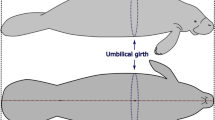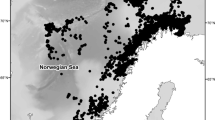Abstract
We investigated the relationships between blubber content and a suite of condition indices in harp seals (Phoca groenlandica). Although blubber content was significantly correlated with xiphosternal blubber depth and “Condition index” they were insensitive indicators of condition. Blubber depth was most variable at a site ca. 60–70% down the length of the body and a more recent index incorporating length, mass and blubber depth devised for phocids was an improved indicator of blubbler mass. Blubber volume was calculated in three ways based on a geometric approximation of a cylinder and also via truncated cones. The cone method accounted for more variance than the other methods although it overestimated blubber mass. Surface area was ascertained using the girth measurements of serial cones and was significantly correlated with total body mass and total body water. We suggest that estimates of total body water generated from surface area could be used to calculate total fat mass and lean body mass
Similar content being viewed by others
References
Beck GG (1990) Evaluation of condition indices relating to seasonal changes and diet of harp seals, Phoca groenlandica Erxleben 1777. M.Sc. thesis. McGill University, Montreal, Quebec
Bowen WD, Sergeant DE, Oritsland T (1983) Validation of age estimation in the harp seal, Phoca groenlandica, using dental annuli. Can J Fish Aquat Sci 40:1430–1441
Bryden MM (1968) Growth and function of the subcutaneous fat of the elephant seal. Nature 220:597–599
Costa DP, Croxall JP, Duck CD (1989) Foraging energetics of Antarctic fur seals in relation to changes in prey availability. Ecology 70:596–606
Croxall JP, McCann TS, Prince PA, Rothery P (1988) Reproductive performance of seals and seabirds at South Georgia and Signey Island, South Orkney islands 1976–1986: implications for Southern Ocean monitoring studies. In: D Sahrhage D (ed) Antarctic Ocean and resources variability. Springer-Verlag, Berlin, pp 261–285
Gales N, Burton H (1987) Ultrasonic measurement of blubber thickness of the Southern elephant seal, Mirounga leonina (Linn.). Aust J Zool 35:207–217
Gales R, Renouf D, Noseworthy E (in press) Body composition of harp seals. Can J Zool
Innes S, Worthy GAJ, Lavigne DM, Ronald K (1990) Surface areas of phocid seals. Can J Zool 68:2531–2538
Lavigne DM, Innes S, Stewart REA, Worthy GAJ (1985) An annual energy budget for Northwest Atlantic harp seals. In: Beddington JR, Beverton RJH, Lavigne DM (eds) Marine mammals and fisheries. George Allen and Unwin Publishers, London, pp 319–336
Lavigne DM, Innes S, Worthy GAJ, Kovacs KM, Schmitz OJ, Hickie JP (1986) Metabolic rate of seals and whales. Can J Zool 64:279–284
Laws RM (1953) The elephant seal, Mirounga leonina Linn. I. Growth and age. Falkland Islands Dependencies Survey Scientific Reports, No. 13
Lockyer CH, McConnell LC, Waters TD (1985) Body condition in terms of anatomical and biochemical assessment of body fat in north Atlantic fin and sei whales. Can J Zool 63:2328–2338
McLaren IA, Smith TG (1985) Population ecology of seals: retrospective and prospective views. Mar mamm Sci 1:54–83
Parsons JL (1977) Metabolic studies on ringed seals (Phoca hispida). M.Sc. thesis, University of Guelph, Guelph
Reilly JJ, Fedak MA (1990) Measurement of the body composition of living gray seals by hydrogen isotope dilution. J Appl Physiol 69:885–891
Renouf D, Gales R, Noseworthy E (1993) Seasonal variation in energy intake and condition of harp seals. Is there a harp seal morph? Problems for bioenergetic modelling. J Zool (Lond)
Ryg M, Smith TG, Oritsland NA (1988) Thermal significance of the topographical distribution of blubber in ringed seals (Phoca hispida). Can J Fish Aquat Sci 45:985–992
Ryg M, Smith TG, Oritsland NA (1990a) Seasonal changes in body mass and body composition of ringed seals (Phoca hispida) on Svalbard. Can J Zool 68:470–475
Ryg M, Lydersen C, Markussen NH, Smith TG, Oritsland NA (1990b). Estimating the blubber content of phocid seals. Can J Fish Aquat Sci 47:1223–1227
Scheffer V (1967) Standard measurements of seals. J Mammal 48:459–462
Schmidt-Neilsen K (1984) Scaling. Why is animal size so important? Cambridge University Press, Cambridge
Sergeant DE (1973) Feeding, growth and productivity of Northwest Atlantic harp seals (Pagophilus groenlandica). J Fish Res Bd Can 30:17–29
Smirnov N (1924) On the eastern harp seal. Tromso Mus Aarsh 47:89
Slip DJ, Burton HR, Gales NJ (1992) Determining blubber mass in the Southern Elephant seal, Mirounga leonina, by ultrasonic and isotopic techniques. Aust J Zool 40:143–152
Stewart REA, Lavigne DM (1984) Energy transfer and female condition in nursing harp seals. Holarctic Ecol 7:182–194
Author information
Authors and Affiliations
Rights and permissions
About this article
Cite this article
Gales, R., Renouf, D. Assessment of body condition of harp seals. Polar Biol 14, 381–387 (1994). https://doi.org/10.1007/BF00240258
Received:
Accepted:
Issue Date:
DOI: https://doi.org/10.1007/BF00240258




